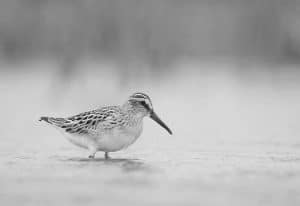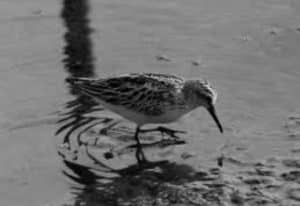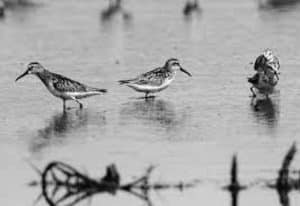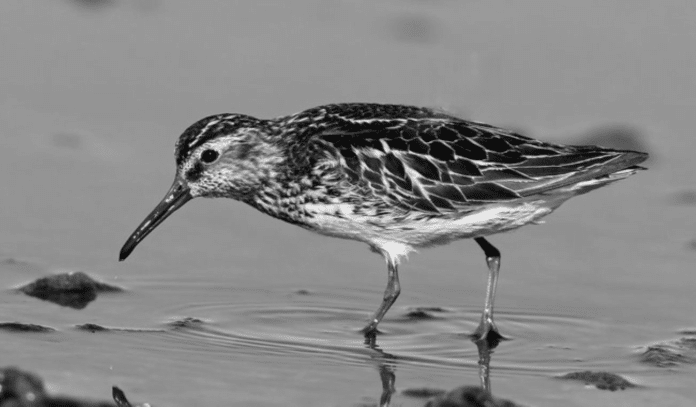Introduction to the Broad-Billed Sandpiper
Welcome to Tanzania, home to a fascinating array of bird species. Among the many remarkable avian creatures that grace the Tanzanian landscape, the broad-billed sandpiper in Tanzania stands out for its unique beak and captivating presence. This elegant wader, scientifically known as Limicola falcinellus, is a treat for bird enthusiasts and nature lovers alike. In this article, we will explore the habitat, migration patterns, behavior, and conservation status of the broad-billed sandpiper, as well as provide tips for observing and photographing these beautiful creatures.
Habitat and Migration Patterns of the Broad-Billed Sandpiper

The broad-billed sandpiper can be found in various habitats across Tanzania, including coastal areas, marshes, and wetlands. These waders prefer areas with shallow water and muddy or sandy substrates, which provide them with ideal feeding grounds. During the breeding season, they migrate to the Arctic tundra in Northern Europe and Asia, where they build their nests amidst the scenic landscapes.
In Tanzania, the broad-billed sandpipers can be observed during their winter migration period. They arrive in the country between August and September and stay until March or April before embarking on their long journey back to the breeding grounds. The shores of Lake Natron and Lake Manyara are particularly popular locations for spotting these elegant birds during their winter stay.
Unique Features of the Broad-Billed Sandpiper’s Beak
One of the most striking features of the broad-billed sandpiper is its beak. As the name suggests, the beak of this wader is broad and slightly upturned, allowing it to probe the soft mud for invertebrates and small crustaceans. This specialized beak shape enables the broad-billed sandpiper to navigate its feeding grounds with ease and precision. With each gentle probing motion, it extracts its preferred delicacies from the depths of the mud, showcasing the remarkable adaptation of this species.
The beak of the broad-billed sandpiper also plays a crucial role in its courtship displays. During the breeding season, males use their beaks to perform intricate and mesmerizing displays to attract a mate. They engage in a variety of behaviors, including bill dipping, head tossing, and wing flapping, all while showcasing their beautiful plumage. These displays serve as a visual spectacle and a testament to the impressive versatility of the broad-billed sandpiper’s beak.
Behavior and Feeding Habits of the Broad-Billed Sandpiper
The broad-billed sandpiper is a highly active and social bird. They are often seen in small flocks, foraging collectively along the shores of lakes and wetlands. These waders have a distinctive feeding behavior, constantly probing the soft mud with their beaks to find their preferred prey. They feed on a variety of invertebrates, including worms, insects, and small crustaceans.
When feeding, the broad-billed sandpiper employs a unique technique known as “sewing machine feeding.” This fascinating behavior involves rapid and continuous up-and-down movements of the head and beak while probing the mud. This motion resembles the needle of a sewing machine, hence the name. It is an efficient way for the bird to locate and capture its prey, showcasing its agility and adaptability.
Conservation Status and Threats to the Broad-Billed Sandpiper

The conservation status of the broad-billed sandpiper is of concern, as it is classified as a near-threatened species by the International Union for Conservation of Nature (IUCN). The population of these waders has been declining in recent years due to several factors. Their breeding grounds in the Arctic are threatened by climate change, which disrupts the delicate balance of the ecosystem. Habitat loss, pollution, and disturbance during migration and wintering grounds also contribute to their vulnerable status.
To ensure the survival of the broad-billed sandpiper and other wader species, conservation efforts are crucial. Protecting their breeding grounds, preserving their wintering habitats, and raising awareness about their importance are vital steps in safeguarding their future. By supporting organizations involved in bird conservation and promoting responsible birdwatching practices, we can contribute to the preservation of these magnificent creatures.
Birdwatching Opportunities in Tanzania for Spotting the Broad-Billed Sandpiper
Tanzania offers several excellent birdwatching opportunities for those eager to catch a glimpse of the broad-billed sandpiper in its winter habitat. Lake Natron and Lake Manyara are renowned birding hotspots, attracting both local and international birdwatchers. These picturesque locations provide a serene backdrop for observing the broad-billed sandpiper and other bird species in their natural environment.
To maximize your chances of spotting these elusive waders, it is advisable to visit during the winter months when they are present in Tanzania. Hiring a local guide with extensive knowledge of the area and bird behavior can greatly enhance your birdwatching experience. They can help you navigate the terrain, identify different species, and provide valuable insights into the behavior and habitat preferences of the broad-billed sandpiper.
Tips for Observing and Photographing the Broad-Billed Sandpiper
Observing and photographing the broad-billed sandpiper requires patience, skill, and a keen eye for detail. Here are a few tips to enhance your experience:
- Use camouflage: Blend in with your surroundings by wearing muted colors and avoiding sudden movements. This will prevent the birds from getting alarmed and increase your chances of getting closer to them.
- Carry the right equipment: A telephoto lens is essential for capturing detailed shots of the broad-billed sandpiper without disturbing their natural behavior. A sturdy tripod can also be useful for stability.
- Observe from a distance: Maintain a respectful distance from the birds to avoid causing stress or disturbance. Use binoculars or a spotting scope to observe their behavior without intruding on their space.
- Be mindful of the environment: Avoid trampling vegetation or disturbing other wildlife while seeking the perfect shot. Respect the delicate balance of the ecosystem and leave no trace of your presence.
Other Wader Species Found in Tanzania
While the broad-billed sandpiper is a star attraction for birdwatchers in Tanzania, the country is also home to a diverse range of other wader species. Some notable examples include the black-winged stilt, the common sandpiper, the pied avocet, and the ruff. These elegant birds can be observed in various habitats across the country, each contributing to the rich tapestry of avian life in Tanzania.
Conclusion: Appreciating the Beauty and Importance of the Broad-Billed Sandpiper

As we conclude our exploration of the broad-billed sandpiper, we are reminded of the beauty and importance of these remarkable creatures. Their unique beak, intricate behaviors, and enchanting presence make them a truly captivating species to observe and admire. However, it is essential to remember that they face significant conservation challenges. By appreciating their beauty and supporting conservation efforts, we can help protect their habitats and ensure that future generations can continue to marvel at the sight of these magnificent waders.


































